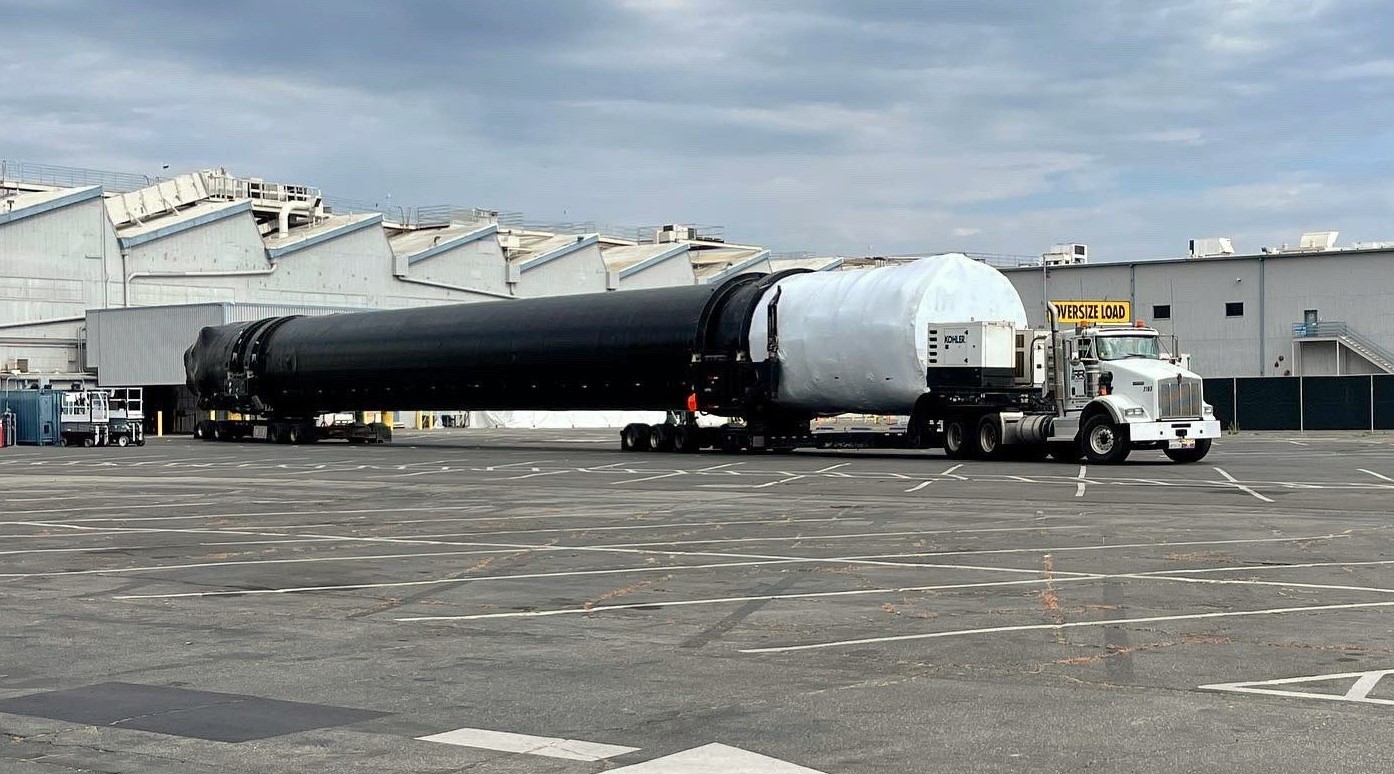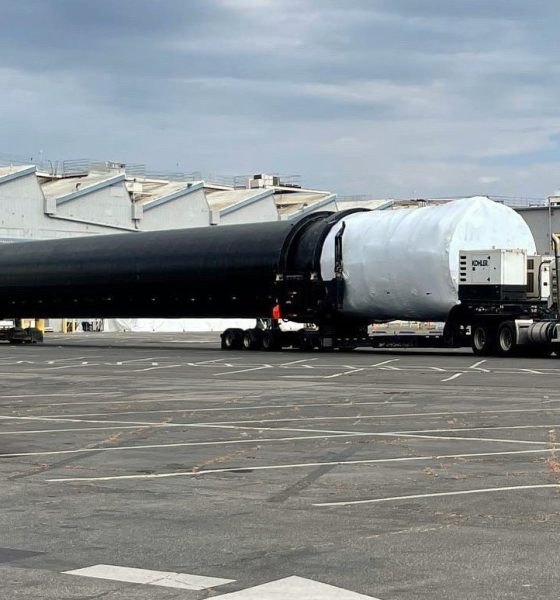

News
SpaceX’s fourth Falcon booster delivery this year hints at rare production uptick
For at least the fourth time in 2021, SpaceX has shipped a new Falcon booster from its Hawthorne, California headquarters and factory to an expansive test and development campus in Central Texas.
By all appearances, SpaceX’s latest delivery could imply that the company is on track to experience its first Falcon booster production uptick in four years. Thanks almost exclusively to the overwhelming success of Falcon reusability, SpaceX has been decreasing booster production year over year since 2017 while (on the whole) still significantly increasing its annual launch cadence. However, that downward booster production trend may have finally come to an end in 2021.
On July 21st, spaceflight journalist Eric Berger spotted a SpaceX Falcon booster – almost impossible to miss on the road – traveling eastbound towards El Paso on a Texas highway. Designed from the start with a maximum diameter (3.6m/12′) explicitly limited to allow Falcon 9 and Falcon Heavy stages to be easily and cheaply transported by road, SpaceX has taken advantage of that capability by making Falcon rockets some of the most extensively tested launch vehicles on Earth.
Most notably, every single Falcon 9 and Falcon Heavy booster and upper stage SpaceX has ever built at its Hawthorne HQ has shipped to McGregor, Texas for qualification testing before being cleared to launch. The exact nature of that qualification testing is unknown but, at minimum, every SpaceX-built stage must eventually complete a clean static fire test before the company deems it qualified for flight and ships it to one of three launch pads.
Before integrated static fire testing, SpaceX also separately tests every single Merlin 1D, Merlin Vacuum, Draco engine, and cold gas thruster before they’re installed on their respective Falcon first stage, second stage, fairing, or Dragon spacecraft back in California. However, Falcon engines, fairings, second stages, and Dragon spacecraft are all small or well-packaged enough to be unassuming on the road. Only Falcon boosters – measuring some 4m (~13 ft) wide and 56m (~190 ft) long and usually wrapped in solid white or black plastic – are routinely spotted in the wild by members of the public.
Those regular public spottings provide the only real glimpse available behind the curtain of SpaceX’s prolific rocket production. Beyond a mishmash of observations from members of the public and the occasional tidbit from CEO Elon Musk, SpaceX – a private company in a very competitive industry – provides no official information about how many Falcon stages it produces each year. That leaves it up to unaffiliated fans to collate and track that activity.
In particular, one Reddit user went to the effort of combing through a decade of those observations to tabulate SpaceX’s annual Falcon first stage production – including Falcon 9 and Falcon Heavy boosters – since 2010. From 2010 to 2017, booster production consistently grew year over year, ultimately peaking at 13 – more than one booster per month – in 2017. Since 2017, booster production has consistently declined, dropping to just five boosters completed in 2020 – the lowest figure since 2013.
Of course, despite building just five new boosters in 2020, SpaceX completed a record 26 Falcon 9 launches, demonstrating just how much of a paradigm shift booster reusability has been for the company. Notably, while booster production has drastically decreased, SpaceX still has to manufacture a new expendable upper stage for every Falcon launch, meaning that – for the most part – Hawthorne is likely as busy as – and soon to be busier than – it was around the 2016-2018 peak.
In a bit of twist, though, that booster production downtick may have bottomed out in 2020. Since May 2020, SpaceX appears to have shipped at least 8 or 9 boosters* from Hawthorne to McGregor. Less than a month ago, a new booster – believed to be Falcon 9 B1069 – went vertical in McGregor ahead of its first wet dress rehearsal and static fire. Less than three weeks later, another new Falcon booster was spotted ready for transport outside of Hawthorne – likely the same booster spotted on its way to McGregor on July 21st.
*Including F9/FH boosters B1061, B1062, B1063, B1064, B1065, B1066, B1067, and B1069
In 2021, SpaceX has delivered one Falcon Heavy (likely B1066) and two Falcon 9 boosters (B1067 and B1069) to McGregor. The mystery booster seen in Hawthorne on July 18th – now likely inside a McGregor hangar as of publishing – is the fourth Falcon first stage to roll out of Hawthorne this year. If SpaceX maintains that average over the next five months, it could ship 6 or even 7 Falcon boosters in 2021 – marking the first apparent production uptick since 2017.

News
Tesla China delivery centers look packed as 2025 comes to a close
Needless to say, it appears that Tesla China seems intent on ending 2025 on a strong note.

Tesla’s delivery centers in China seem to be absolutely packed as the final days of 2025 wind down, with photos on social media showing delivery locations being filled wall-to-wall with vehicles waiting for their new owners.
Needless to say, it appears that Tesla China seems intent on ending 2025 on a strong note.
Full delivery center hints at year-end demand surge
A recent image from a Chinese delivery center posted by industry watcher @Tslachan on X revealed rows upon rows of freshly prepared Model Y and Model 3 units, some of which were adorned with red bows and teddy bears. Some customers also seem to be looking over their vehicles with Tesla delivery staff.
The images hint at a strong year-end push to clear inventory and deliver as many vehicles as possible. Interestingly enough, several Model Y L vehicles could be seen in the photos, hinting at the demand for the extended wheelbase-six seat variant of the best-selling all-electric crossover.
Strong demand in China
Consumer demand for the Model Y and Model 3 in China seems to be quite notable. This could be inferred from the estimated delivery dates for the Model 3 and Model Y, which have been extended to February 2026 for several variants. Apart from this, the Model Y and Model 3 also continue to rank well in China’s premium EV segment.
From January to November alone, the Model Y took China’s number one spot in the RMB 200,000-RMB 300,000 segment for electric vehicles, selling 359,463 units. The Model 3 sedan took third place, selling 172,392. This is quite impressive considering that both the Model Y and Model 3 are still priced at a premium compared to some of their rivals, such as the Xiaomi SU7 and YU7.
With delivery centers in December being quite busy, it does seem like Tesla China will end the year on a strong note once more.
News
Tesla Giga Berlin draws “red line” over IG Metall union’s 35-hour week demands
Factory manager André Thierig has drawn a “red line” against reducing Giga Berlin’s workweek to 35 hours, while highlighting that Tesla has actually increased its workers’ salaries more substantially than other carmakers in the country.

Tesla Giga Berlin has found itself in a new labor dispute in Germany, where union IG Metall is pushing for adoption of a collective agreement to boost wages and implement changes, such as a 35-hour workweek.
In a comment, Giga Berlin manager André Thierig drew a “red line” against reducing Giga Berlin’s workweek to 35 hours, while highlighting that Tesla has actually increased its workers’ salaries more substantially than other carmakers in the country.
Tesla factory manager’s “red line”
Tesla Germany is expected to hold a works council election in 2026, which André Thierig considers very important. As per the Giga Berlin plant manager, Giga Berlin’s plant expansion plans might be put on hold if the election favors the union. He also spoke against some of the changes that IG Metall is seeking to implement in the factory, like a 35-hour week, as noted in an rbb24 report.
“The discussion about a 35-hour week is a red line for me. We will not cross it,” Theirig said.
“(The election) will determine whether we can continue our successful path in the future in an independent, flexible, and unbureaucratic manner. Personally, I cannot imagine that the decision-makers in the USA will continue to push ahead with the factory expansion if the election results favor IG Metall.”
Giga Berlin’s wage increase
IG Metall district manager Jan Otto told the German news agency DPA that without a collective agreement, Tesla’s wages remain significantly below levels at other German car factories. He noted the company excuses this by referencing its lowest pay grade, but added: “The two lowest pay grades are not even used in car factories.”
In response, Tesla noted that it has raised the wages of Gigafactory Berlin’s workers more than their German competitors. Thierig noted that with a collective agreement, Giga Berlin’s workers would have seen a 2% wage increase this year. But thanks to Tesla not being unionized, Gigafactory Berlin workers were able to receive a 4% increase, as noted in a CarUp report.
“There was a wage increase of 2% this year in the current collective agreement. Because we are in a different economic situation than the industry as a whole, we were able to double the wages – by 4%. Since production started, this corresponds to a wage increase of more than 25% in less than four years,” Thierig stated.
News
Tesla is seeing a lot of momentum from young Koreans in their 20s-30s: report
From January to November, young buyers purchased over 21,000 Teslas, putting it far ahead of fellow imported rivals like BMW and Mercedes-Benz.

Tesla has captured the hearts of South Korea’s 20s-30s demographic, emerging as the group’s top-selling imported car brand in 2025. From January to November, young buyers purchased over 21,000 Teslas, putting it far ahead of fellow imported rivals like BMW and Mercedes-Benz.
Industry experts cited by The Economist attributed this “Tesla frenzy” to fandom culture, where buyers prioritize the brand over traditional car attributes, similar to snapping up the latest iPhone.
Model Y dominates among young buyers
Data from the Korea Imported Automobile Association showed that Tesla sold 21,757 vehicles to the 20s-30s demographic through November, compared to BMW’s 13,666 and Mercedes-Benz’s 6,983. The Model Y led the list overwhelmingly, with variants like the standard and Long Range models topping purchases for both young men and women.
Young men bought around 16,000 Teslas, mostly Model Y (over 15,000 units), followed by Model 3. Young women followed a similar pattern, favoring Model Y (3,888 units) and Model 3 (1,083 units). The Cybertruck saw minimal sales in this group.
The Model Y’s appeal lies in its family-friendly SUV design, 400-500 km range, quick acceleration, and spacious cargo, which is ideal for commuting and leisure. The Model 3, on the other hand, serves as an accessible entry point with lower pricing, which is valuable considering the country’s EV subsidies.
The Tesla boom
Experts described Tesla’s popularity as “fandom culture,” where young buyers embrace the brand despite criticisms from skeptics. Professor Lee Ho-geun called Tesla a “typical early adopter brand,” comparing purchases to iPhones.
Professor Kim Pil-soo noted that young people view Tesla more as a gadget than a car, and they are likely drawn by marketing, subsidies, and perceived value. They also tend to overlook news of numerous recalls, which are mostly over-the-air software updates, and controversies tied to the company.
Tesla’s position as Korea’s top import for 2025 seems secured. As noted by the publication, Tesla’s December sales figures have not been reported yet, but market analysts have suggested that Tesla has all but secured the top spot among the country’s imported cars this year.








